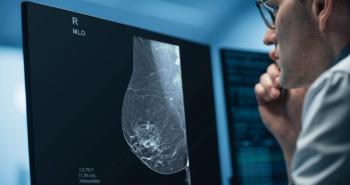
Synthetic vs Digital 2D Mammography in Breast Density Assessment
Synthetic vs digital 2D mammograms in assessing breast tissue density.
Despite some reader variability, synthetic 2D mammography is comparable with digital 2D mammography to assess breast tissue density, according to a study published in the
Researchers from the University of Virginia Health System in Charlottesville performed a retrospective study to compare assessments of breast density between synthetic and digital 2D mammograms. Images from 309 patients were included in the study. All had undergone screening with digital 2D mammography and tomosynthesis during May 2015 with a negative or benign outcome.
Three radiologists with five to 25 years of clinical experience and one year of experience with synthetic 2D mammography read the digital 2D and synthetic 2D images in separate reading sessions, and assigned breast density categories according to the 5th edition of BI-RADS.
The results showed agreement between consensus BI-RADS density categories assigned for digital and synthetic 2D mammography was 80.3% and for combined dense and nondense categories, agreement reached 91.9%. For consensus readings, similar numbers of patients were shifted between nondense (11) and dense categories (14) with the synthetic 2D compared with digital 2D mammography.
The differences between readers were apparent; assignment to dense categories was greater with digital 2D mammography for reader 1 and for reader 2, but greater with synthetic 2D mammography for reader 3.
The researchers concluded that overall, synthetic 2D mammography was comparable with digital 2D mammography in assessment of breast density. They did note some variability by reader. “Practices can readily adopt synthetic 2D mammography without concern that it will affect density assessment and subsequent recommendations for supplemental screening,” they wrote.
Newsletter
Stay at the forefront of radiology with the Diagnostic Imaging newsletter, delivering the latest news, clinical insights, and imaging advancements for today’s radiologists.




























